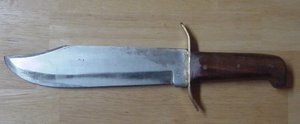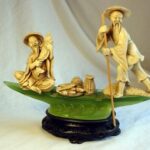Bowie knives have been depicted in movies and novels as having large, clip-pointed blades (a concave arch at the tip), ivory handles, and ornate crossguards made from brass or silver. But did knives used by the early frontiersman really resemble this accepted version of what is now called a bowie knife? Did Jim Bowie actually carry a knife with any of the characteristics listed above?
Long before Jim Bowie ever existed, large knives similar to the butcher’s type played an indispensable role in all aspects of frontier life. These knives were used for skinning and butchering game, clearing trails, splitting kindling, cutting branches, making pottery over fires, digging up herbs, making small foxholes, carving spokes and repairing broken wagon wheels, along with many other uses. Large knives were used by everyone from farmer’s wives to soldiers, and for everything from self defense to emergency last-resort surgeries, such as amputation.
These large knives were very similar to a common butcher’s knife and could be obtained from trading posts, or cutlers and blacksmiths in various towns and settlements. But most frontier people were frugal and self-reliant, so they made their own knives from worn-out or discarded items such as cross-cut saw blades, files, or scythes. Or they may have traded some of their own goods for a homemade knife of the type described above. They were simple and serviceable with a blade approximately a foot in length that contained a simple piece of wood or maybe an antler for a handle; and these simplistic knives were highly effective.
So how did Bowie knives become so popular? What exactly puts the ‘bowie’ in a bowie knife? There are numerous legends surrounding the fight that is now known as the “Sandbar Duel” that involved Jim Bowie and which took place on September 19th, 1827 where Bowie used his knife to defend his own life. The duel began because of Jim Bowie’s friend, Samuel Levi Wells, being challenged to a duel by a Doctor Thomas Maddox. Bowie and Wells arrived at the designated area near Natchez, Lousianna with Bowie intending to act as Wells’ second; and Bowie was carrying a knife made by a plantation blacksmith. They were also accompanied by various friends of Wells and Bowie, and on the opposing side were Maddox and his acting second, along with more of Maddox’s friends. The duel began and the men both fired shots, but neither of them was hit. So they agreed that their grievances were settled and started to leave. But the bystanders around them began arguing and soon a vicious fight erupted.
Two men were shot dead and several more were wounded. Jim Bowie himself was shot by a man named Norris Wright, and as Bowie fell injured, Wright rushed him with a sword-cane, trying to finish him off. But remarkably Bowie was able to deflect the sword as he unsheathed his knife and quickly disemboweled Wright as Bowie pulled him on top of the blade. Bowie then wounded another attacker who eventually ran away.
Soon word spread of Bowie’s incredible feat of winning a fight after he was stabbed, shot, and severely beaten. Other men who heard about the Sandbar Duel immediately wanted a knife exactly like Bowie’s. Hence, the modern bowie knife was born. Men asked cutlers and blacksmith’s to make them a knife like Jim Bowie’s, and the craftsmen responded to the intense demand by making large, menacing looking knives with ivory or ebony handles and protective crossguards.
Interestingly, some manufacturers would etch clever motifs into the blades, such as ‘I NEVER FAIL’ and ‘SELF-DEFENDER’ and ‘I’M A REAL RIPPER.’ Other popular phrases were ‘SUPERIOR BOWIE KNIFE’ and ‘YIELD TO NONE,’ or ‘Texas Ranger Knife,’ ‘Death to Traitors,’ ‘Arkansas Toothpick,’ ‘Patriot’s Self Defender,’ ‘Americans Never Surrender,’ and others.
Foreign cutlers also tried to meet the demand for Bowie knives. The British had dominated the cutlery market ever since colonial days and soon Bowie knives arrived with Sheffield Stampings. Some British Bowie blades had a symmetrical spear shape while others were straight backed, but most had a clip-point design.
Jim Bowie’s brother, Rezin, began presenting Bowie knives to his acquaintances. One original Rezin presentation knife is in the Mississippi State Historical Museum and another is displayed in the Alamo Museum in San Antonio Texas.
Legend says that Rezin Bowie had hired a blacksmith by the name of James Black to produce the first ever Bowie knife to his exact specifications. In a letter written from Iberville Louisiana, August 24th, 1838 Rezin Bowie states, “The first Bowie knife was made by myself in the parish of Avoyelles, in this state, as a hunting knife, for which purpose, exclusively, it was used for many years. The length of the knife was 9 1/4 inches, its width 1 1/2 inches, single edged and the blade not curved.”
This description matches the Rezin presentation knives and also the “Spanish Dagger,” which was a style of knife used in Lousiana after years of French and Spanish dominance. The Spanish Dagger, like the Rezin knives, had no crossgaurd and no clip point as British knives had. But because the blade is wider than the handle there is no need for a crossguard. Also knives of this simple, straightforward design resemble original home-wrought knives that were used on the early frontier.
The Bowie knife that we know today is not made up of any one main design, but actually refers to many types of knives that were designed over a long span of time. Even in modern magazines today you will run across knife ads where they are labeled as Bowie knives, but actually look identical to a common butcher’s knife.
Interesting fact: It’s a misdemeanor to carry a Bowie knife in the state of Texas, although one can be transported in your vehicle.
Sources:
The Backwoodsman Magazine, Volume 28 No. 2 March issue, 2007.
Guns of the World, Bonanza books: A division of Crown Publishers Inc. New York, 1977.
Bowie Knife, Wikipedia, http://en.wikipedia.org/wiki/Bowie_knife






